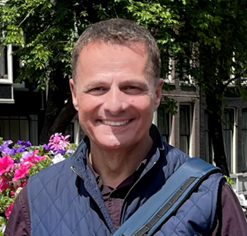Appreciative Resources
Review by Nicole Morris
Dr Nicole S. Morris is Associate Professor and LaMarche Endowed Chair at Saint Michael’s College, where she teaches accounting, management and entrepreneurship. She holds a Ph.D. in Management, an MBA, and a B.B.A. in accounting. A licensed CPA and CGMA, Nicole’s research focuses on sustainable business practices and experiential learning. She previously served as the Robert P. Stiller Endowed Chair of Management at Champlain College.
PIVOT: The Road to Transforming the World of Work Tenny Poole
Highpoint Executive Publishing, 2024
ISBN (hard copy) 979-8989777365
ISBN-13 (paperback) 979-8989777365
Also available in Kindle edition and in Audiobook format
Tenny Poole’s Pivot: The Road to Transforming the World of Work offers an inspiring and timely contribution to Appreciative Inquiry (AI) scholarship and practice. Written with clarity, accessibility and conviction, the book illustrates how AI can shape organizations into human-centered, adaptable, purpose-driven communities of practice.
Drawing on her decades of experience as a leadership development practitioner and executive coach, Poole brings a rare blend of practical insight and visionary perspective. Her career has spanned senior leadership in human resources, including serving as vice president of HR at Experian, where she used Appreciative Inquiry to guide large-scale transformation initiatives and international expansion.
As founder and principal of the West Coast Center for Positive Change and a principal with the Corporation for Positive Change, she has trained, coached and consulted with leaders across sectors to build cultures rooted in strengths, trust and collaboration. This deep well of experience grounds her call to move away from deficit-based change management toward approaches that amplify existing strengths and co-create new possibilities.
Pivot is rooted in Poole’s belief and experience that transformation begins with recognizing and amplifying existing strengths rather than focusing on deficits. This perspective runs counter to much traditional change management, which often dwells on problems. Poole’s emphasis is on possibility, highlighting how leaders and teams can co-create new futures through dialogue, shared vision and collective action. The result is an approach that not only transforms internal operations but also strengthens an organization’s capacity to contribute positively to the broader systems in which it operates.
Appreciative Inquiry and human systems
Poole begins by revisiting the foundations of AI, reminding readers of David Cooperrider’s groundbreaking approach to discovering the “life-giving forces” present within every organization. She then turns to the reality of today’s world of work: increasing complexity, rapid technological change, shifting employee expectations and the need for agility in the face of disruption. Against this backdrop, “pivoting” is presented not as a reactive move, but as an intentional, proactive shift that centers purpose while embracing innovation and experimentation.
Poole provides case examples from a wide range of sectors: a multinational corporation redesigning its leadership development programs to foster inclusion and equity; a manufacturing company using AI summits to address the challenges of automation while protecting employee engagement; a nonprofit reframing its mission to better serve communities in a digital-first world; and many others.
These stories demonstrate AI in action, whether in small shifts such as reducing meeting fatigue, or in large-scale, multi-stakeholder summits, showing how its principles can generate tangible results ranging from improved collaboration and morale to breakthrough innovations in products and services. They illustrate how shifts in workplace culture can ripple outward, demonstrating the potential to influence industry norms and community wellbeing.
Relationships, wellbeing and possibility
Several powerful themes emerge from Poole’s cases. The first is that transformation begins with relationships. Time and again, she shows how Appreciative Inquiry creates the conditions for trust, connection and shared purpose, whether in a leadership team rebuilding cohesion or in cross-functional groups aligning around common aspirations.
A second theme centers on wellbeing and culture. Poole highlights how organizations can co-create systems and policies that honor both performance and people. In one example from the health and wellness sector, AI was used to design flexible work practices that supported mental health, improved retention and reinforced a culture where individuals could thrive. These examples remind us that workplace systems can be intentionally designed to sustain energy, commitment and long-term success.
A third theme is the ability to navigate uncertainty with a lens of possibility. Rather than treating economic disruption or global crises as threats only, organizations in these stories reframed uncertainty as an opening for creativity and innovation. This shift in perspective often produced new business models and surprising opportunities for growth, showing how values-based adaptability can become a true source of resilience.
The roadmap for positive leadership
One of the most valuable contributions of Pivot is Poole’s Roadmap for positive leadership, which distills AI into eight interconnected components: positivity, psychological safety, human-centered, strengths, trust, inspiration, positive change and teamwork. The power of this framework lies in its holistic nature. Each element is meaningful on its own; together, they create the conditions for organizations to flourish in ways that are both sustainable and generative.
Positivity is grounded in neuroscience and reminds us that people are their best selves when they are in a state of positive emotion. Psychological safety ensures that individuals feel secure enough to speak up, contribute and innovate. Human-centered reminds us that listening, respect, compassion, emotional intelligence, engagement and humility are the cornerstones of effective leadership. When these foundations are in place, organizations can more effectively identify and leverage strengths, which in turn fosters deeper trust. Trust is the glue that allows relationships to thrive and creates a reliable base for collaboration. From there, inspiration – through vision and shared purpose – mobilizes energy and commitment, leading to positive change that is rooted in co-creation rather than imposed solutions. Finally, teamwork reinforces the relational essence of leadership, ensuring that efforts are collective and outcomes are sustained.
What makes this roadmap so compelling is that it frames leadership not as a set of directives but as a living system. It demonstrates that transformation requires more than strategy; it calls for a culture that supports possibility, connection and shared accountability. Taken together, these eight components reflect a pathway for leadership that is both practical and aspirational, positioning organizations to not only navigate complexity but also to shape the future with intention and care.
AI principles in action
One of the book’s strengths is the way Poole illustrates AI principles in practice. The Simultaneity principle is evident in the story of a mid-level manager whose understanding of her role shifted during the very conversations intended to shape the team’s future. The Anticipatory principle comes alive when leaders envision a hybrid work culture that balances flexibility with connection – and take immediate steps toward realizing it. The Constructionist principle is shown in organizations that consciously shift their internal narratives from “keeping up” to “leading change”, changing both language and strategy. The Positive principle emerges in Poole’s focus on stories of resilience, while the Poetic principle is woven throughout, as challenges are framed as chapters in an unfolding narrative rather than fixed problems.
In addition to the core five principles, Poole introduces emergent AI principles identified by Whitney and Trosten-Bloom (2010), such as the Wholeness and Narrative principles, and explores how they might be applied in today’s workplace. This discussion reinforces the idea that sustainable change honors the interconnectedness of people, processes and the larger systems they inhabit.
An evaluative summary of the book
Pivot succeeds on several levels. For practitioners, it offers clear guidance on designing and facilitating AI-based change processes that are both aspirational and pragmatic. For leaders, it provides a lens for viewing the workplace as a dynamic, evolving system where every conversation has the potential to influence culture and direction. For researchers and students of AI, it presents well-chosen examples that illuminate theory in practice.
What stands out is the book’s accessibility. Poole’s writing is straightforward without oversimplifying, which makes it equally valuable for AI newcomers and experienced facilitators. The reflective questions at the end of each chapter invite genuine engagement, encouraging readers to pause, connect insights to their own experiences, and use the book not only as a resource but as a springboard for meaningful change.
Pivot is a practical guide grounded in real-world application. It is not simply about responding to change; it is about shaping it in ways that honor values, strengthen relationships, and create environments where people can truly flourish. By centering on strengths, purpose and shared vision while situating organizational transformation within a broader ecosystem perspective, Poole makes a compelling case for workplaces as active contributors to more just and resilient futures.
For leaders, consultants, educators or change agents navigating the complexities of today’s workplace, this book offers both inspiration and practical tools. It adds meaningful depth to the growing body of Appreciative Inquiry resources and speaks to those who believe the future of work can and should be intentionally designed to support the wellbeing of all.








 Andrew Lynch
Andrew Lynch Cees Hoogendijk
Cees Hoogendijk Keith Storace is a registered psychologist with the Psychology Board of Australia (PsyBA) and an associate fellow with the Australasian College of Health Service Management (ACHSM). He manages a private practice at Kiku Imagination where he applies the Appreciative Dialogue (ApDi) therapy program to assist individuals move toward, strengthen and enjoy what is meaningful while dealing with the challenges they encounter along the way.
Keith Storace is a registered psychologist with the Psychology Board of Australia (PsyBA) and an associate fellow with the Australasian College of Health Service Management (ACHSM). He manages a private practice at Kiku Imagination where he applies the Appreciative Dialogue (ApDi) therapy program to assist individuals move toward, strengthen and enjoy what is meaningful while dealing with the challenges they encounter along the way.